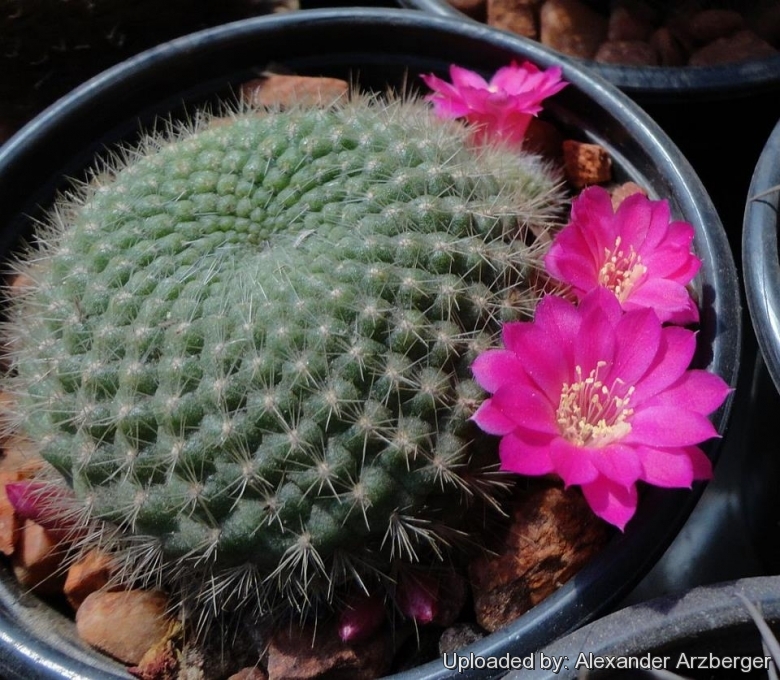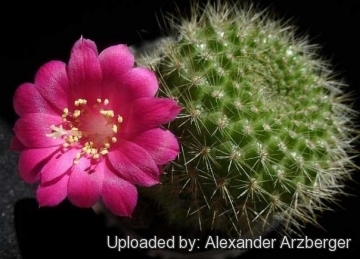Accepted Scientific Name: Rebutia minuscula K.Schum.
Monatsschr. Kakteenk. 5: 102, cum xylogr. 1895

Rebutia violaciflora Photo by: Alexander Arzberger
Origin and Habitat: Northern Argentina, Salta, above Quebrada Escoipe, at an altitude of around 3000 metres above sea level.
Synonyms:
See all synonyms of Rebutia minuscula
back
Accepted name in llifle Database:Rebutia minuscula K.Schum.Monatsschr. Kakteenk. 5: 102, cum xylogr. 1895Synonymy: 65
back
Description: Rebutia violacifloraSN|15391]]SN|15442]] is another lovely variety that features golden yellow spines that grow 25 mm long and a yellow-green, clump-forming, globular body. It carries large, funnel-shaped, light-violet blossoms in the early spring. Rebutia violacifloraSN|15442]]SN|15442]] is one of the morphological or local forms of Rebutia minusculaSN|15442]]SN|15391]], but the differences are in reality very minimal and the two plants are not readily distinguishable, if not flowering. More likely they are one and the same species, but it still has a value for a collector because they identify plants with particular characters. These light-violet flowered plants found in our collections, are almost always raised from selected self-pollinating strains and autogamy preserve this character in pureness, but in natural populations the colour of flowers ranges from red to purple, to violet and specific colouration such as violet is often the result of artificial selections.
Stems: Hemispherical or sometime globular, small usually less than 20 mm diameter (often larger in cultivation), usually solitary and depressed at apex. Deep yellow green.
Ribs: Completely divided in flat, rounded, spiralled tubercles.
Areoles: Round, round, 1 mm diameter, yellowish tomentose.
Spines: About 20, bristle-like, stiff, radiating, ranging from 3-25 mm in length. There are also some central spines, hardly distinguishable and somewhat stronger. All are deep golden-brown, tan or brown.
Flowers: Funnel shaped, 30-35 mm long, 25-30 mm wide at top, light violet-red and self-fertile. Ovary, about 3 mm wide crimson colored, with brownish triangular scales, c. 1 mm large, with very short woolly felts in their axils. Floral tube briefly flared, about 10 mm long, c 2 mm in diameter at the base, 7 mm wide above, brownish pink, with 2-6 mm long and 1-2 mm wide, reddish brown, naked, pointed scales. Outer perianth segments acutely lanceolate with spiny tip, purplish pink; inner perianth segments oval lanceolate with spiny tip, 15 mm long, 6 mm wide, purple-pink. Filaments white, 5-10 mm long, anthers small, spherical, yellow. Pistil, 20 mm long, thin, reddish pink to whitish, with five yellowish to whitish lobes, 2-3 mm long.
Fruit: Spherical, about 6 mm wide, orange-yellow, later browning, drying and cracking irregularly.
Seeds: Oblong, about 1 mm long, with shiny, black, finely warty testa and a large white hilum.
Subspecies, varieties, forms and cultivars of plants belonging to the Rebutia minuscula group
- Rebutia chrysacantha Backeb.: This name is applied to plants with stiffer spines, yellowish with brown tips, and with reddish-orange flowers.
 Rebutia chrysacantha var. elegans (Backeb.) Backeb.: has stiff whitish spines and reddish-orange flowers. The name is derived from the overall appearance of the variety, with elegant, neat, spines spirally arranged.
Rebutia chrysacantha var. elegans (Backeb.) Backeb.: has stiff whitish spines and reddish-orange flowers. The name is derived from the overall appearance of the variety, with elegant, neat, spines spirally arranged.- Rebutia grandiflora Backeb.
 Rebutia minuscula K.Schum.: is a small clumping cactus species, widespread and extremely variable. Flowers orange-red to violet. Distribution: northern Argentina (Catamarca, Jujuy, Salta and Tucumán)
Rebutia minuscula K.Schum.: is a small clumping cactus species, widespread and extremely variable. Flowers orange-red to violet. Distribution: northern Argentina (Catamarca, Jujuy, Salta and Tucumán)  Rebutia minuscula subs. edeltraudianae n.n.: has yellow-orange flowers (= Rebutia xanthocarpa). Distribution: Sierra Medina, Tucuman, Argentina.
Rebutia minuscula subs. edeltraudianae n.n.: has yellow-orange flowers (= Rebutia xanthocarpa). Distribution: Sierra Medina, Tucuman, Argentina. Rebutia minuscula f. kariusiana (Wessner) Donald: has pink-violet flowers and shows transitional characters between Rebutia minuscula subs. violaciflora and Rebutia wessneriana subs. beryllioides.
Rebutia minuscula f. kariusiana (Wessner) Donald: has pink-violet flowers and shows transitional characters between Rebutia minuscula subs. violaciflora and Rebutia wessneriana subs. beryllioides. Rebutia senilis Backeb.: has bristly, glassy, white spines up to 30 mm long that largely covers the stems and very showy orange or crimson blooms. Distribution: Salta, Argentina.
Rebutia senilis Backeb.: has bristly, glassy, white spines up to 30 mm long that largely covers the stems and very showy orange or crimson blooms. Distribution: Salta, Argentina. Rebutia senilis var. iseliniana Krainz: has bright orange or orange-red (occasionally yellow) flowers and thinner spines, sometimes pure white, often with a yellowish cast.
Rebutia senilis var. iseliniana Krainz: has bright orange or orange-red (occasionally yellow) flowers and thinner spines, sometimes pure white, often with a yellowish cast. Rebutia senilis var. lilacino-rosea Backeb.: has pink-violet flowers that distinguishes it from other varieties of Rebutia senilis.
Rebutia senilis var. lilacino-rosea Backeb.: has pink-violet flowers that distinguishes it from other varieties of Rebutia senilis. Rebutia violaciflora Backeb.: has light-violet blossoms in the early spring. It is a selected colour strain.
Rebutia violaciflora Backeb.: has light-violet blossoms in the early spring. It is a selected colour strain. Rebutia violaciflora var. albispina hort.: has pink-violet flowers and glassy-white spines intermediate between the short, spines of Rebutia minuscula and the long spines of Rebutia senilis.
Rebutia violaciflora var. albispina hort.: has pink-violet flowers and glassy-white spines intermediate between the short, spines of Rebutia minuscula and the long spines of Rebutia senilis.- Rebutia violaciflora var. carminea (Buining) Donald
- Rebutia xanthocarpa var. graciliflora Backeb. ex Šída
Bibliography: Major references and further lectures
1) Cyril Marsden, Herbert Spencer Jackson “Rebutia, Including Aylostera and Sulcorebutia” Macmillan, 1968
2) Hans Hecht “Cacti & succulents” Sterling Pub. Co., 1997
3) “Botanica: The Illustrated A-Z of Over 10,000 Garden Plants and how to Cultivate Them” Mynah, 1997
4) Wikipedie: Otev?ená encyklopedie: Rebutia violaciflora [online]. c2015 [citováno 29. 03. 2016]. Dostupný z WWW: <https://cs.wikipedia.org/w/index.php?title=Rebutia_violaciflora&oldid=13073766>
5) Backeberg, Curt, “Die Cactaceae”, 3: 1549, 1959
6) Backeberg, Curt, “Das Kakteenlexikon”, p. 385, 1966
7) Backeberg, Curt; Knuth, Frederic Marcus, “Kaktus-ABC”, p. 278, 1936
8) Donald, John Donald “The Classification of the Rebutias” Ashingtonia, 2: 43, 1975
9) Hlinecký, Antonín, “Rod Rebutia K. Schumann” Fri?iana, 5/36: 12, 1965
10) Krainz, Hans, “Die Kakteen”, 14: CVc, 1960
11) Pilbeam, John, “Rebutia”, p. 110, 1997
12) Šída, Otakar, “Rod Rebutia”, p. 32, 1997
 Rebutia violaciflora Photo by: Alexander Arzberger
Rebutia violaciflora Photo by: Alexander Arzberger Rebutia violaciflora Photo by: Peiffer Clement
Rebutia violaciflora Photo by: Peiffer ClementCultivation and Propagation: Rebutia violacifloraSN|15391]]SN|15442]] is a summer grower species that is easy to cultivate and recommended for beginners. The whole Rebutia minusculaSN|15442]]SN|15391]] complex has delightful flowers and the plants remain compact, and clumps can easily be managed by division. Another advantage is that the plants are very cold hardy in Winter if kept dry.
Growth rate: It is a slow growing but easily flowering species that will make clumps given the best conditions.
Soils: It likes very porous standard cactus mix soil with a pH slightly on the acidic side.
Repotting: This species will occupy a small flower pot comfortably and remain a manageable sized house plant, repotting should be done every other year or when the it has outgrown its pot. Use pot with good drainage.
Watering: Needs moderate to copious waterings in summer, but do not overwater (the root system is rot prone) and allow the pot to dry out between waterings. Keep dry in winter at a minimum temperature of 0°C.
Fertilization: Feed with a high potassium fertilizer in summer.
Hardiness: It is reputedly resistant to frost if kept on the dry side prior to, and during, cold weather and requires a winter rest period (hardy to -7 C ° C, or less for short periods), but for safe cultivation it is best to avoid freezing temperatures. It does not like high temperatures in summer, and will be perfectly happy in pots outdoors from April to September if protected from torrential rain and hail
Exposition: The plant tolerates extremely bright situations but enjoys filtered sunlight or afternoon shade, inside it needs bright light, and some direct sun. Tends to bronze in strong light, which encourages flowering and heavy spine production, but is likely to suffer from sun scorch or stunted growth if over exposed to direct sunlight during the hottest part of the day in summer.
Uses: It is an excellent plant for container growing. It always looks good and stays small. It look fine in a cold greenhouse and frame or outdoor in a rockery.
Pests & diseases: It may be attractive to and liable to damage by spider mites and thrips
but plants in good condition should be nearly pest-free, particularly if they are grown in a mineral potting-mix, with good exposure and ventilation.
Rot: This species is particularly easy and accommodating, seldom suffer of cryptogamic diseases. Rot it is only a minor problem with rebutias if the plants are watered and “aired” correctly. If they are not, fungicides won't help all that much.
Propagation: Division, direct sow after last frost. Seeds germinate in 7-14 days at 21-27° C in spring, remove gradually the glass cover as soon the plants will be well rooted (ca 1-2 weeks) and keep ventilated, no full sun for young plants! To make a cutting twist off a branch and permit it to dry out a couple of weeks, lay it on the soil and insert the stem end partially into the soil. Try to keep the cutting somewhat upright so that the roots are able to grow downward.
Note: It would appear that in cultivation they grow larger and cluster more vigorously than in habitat.












